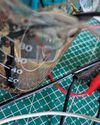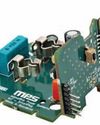ROLE OF SECURE BOOT In Securing IoT Devices
September 2025
|Electronics For You
Security of IoT devices is critical as they are ubiquitous in home and industrial environments today. Secure boot is a security feature designed to ensure that only trusted software runs during a device's startup process.

Low-end embedded devices are becoming increasingly popular due to their compact design and ease of use. These devices have seamlessly integrated into our daily lives, powering everything from smart home appliances to industrial IoT systems. However, their widespread adoption has also exposed them to significant security risks. One major concern is their vulnerability to malicious software injections. This is particularly critical given their limited user interface and lower levels of direct user oversight, which make detecting such threats challenging. To address this, the concept of secure boot has been introduced as a pivotal security measure for IoT devices.
Secure boot ensures that only trusted and authenticated software is allowed to run during the startup process. By leveraging cryptographic techniques, this mechanism validates the integrity and authenticity of the firmware, safeguarding these devices against unauthorised modifications and malicious code. As the reliance on embedded devices continues to grow, implementing robust security measures like secure boot will play a vital role in ensuring their safe and reliable operation.
The role of firmware in IoT devices
Embedded devices rely on a bootloader code that plays a crucial role in the startup process by loading the firmware. Firmware is a specialised piece of software stored in the device's nonvolatile memory, often referred to as read-only memory (ROM). This firmware enables the device to perform its intended functions and is composed of several key components, including the kernel, bootloader, filesystem, and additional resources. It is also responsible for ensuring the proper operation of various hardware components within the device.
هذه القصة من طبعة September 2025 من Electronics For You.
اشترك في Magzter GOLD للوصول إلى آلاف القصص المتميزة المنسقة، وأكثر من 9000 مجلة وصحيفة.
هل أنت مشترك بالفعل؟ تسجيل الدخول
المزيد من القصص من Electronics For You

Electronics For You
Tech Majors Are Racing TOWARDS NET-ZERO - What About You?
Apple, Microsoft, Amazon, Google, Infosys, Wipro—global and Indian firms are heading closer to achieving net-zero emissions, a mandate to combat climate change. Here is what you need to know to start your journey...
12 mins
December 2025

Electronics For You
Miniature IoT WATER TDS And LEVEL MONITOR Cum CONTROLLER
For setups that rely on stored water, clear awareness of tank level and water quality is essential.
3 mins
December 2025

Electronics For You
The Impact Of GENERATIVE AI On The Future Of AUTOMOTIVE AND EVs
Autonomous vehicles, connected ecosystems, and smart factories are only the beginning. Generative Al is pushing the auto industry beyond predictions into a bold era of creativity-from EV design to real-time diagnostics and showroom automation. Here is how GenAl is reshaping innovation across the automotive value chain.
8 mins
December 2025

Electronics For You
How AI Tools Are Making SOFTWARE DEVELOPMENT BETTER
AI is reshaping how we code, debug, and collaborate. From Copilot to automation, it is changing software development in ways worth exploring.
3 mins
December 2025
Electronics For You
How AI Tools Are Making SOFTWARE DEVELOPMENT BETTER
AI is reshaping how we code, debug, and collaborate. From Copilot to automation, it is changing software development in ways worth exploring.
3 mins
December 2025

Electronics For You
5 Interesting Reference Designs FOR SMART HOMES
Smart home devices are transforming the way people interact with their appliances. They make homes more convenient, secure, and energy-efficient. From smart plugs and energy monitors to smart locks and thermostats, reference designs help design engineers create connected products that are easy to use, consume less power, and are reliable. These designs allow you to control devices remotely, track energy use, extend battery life, and automate routines. They provide practical solutions for upgrading homes and small commercial spaces without major modifications.
3 mins
December 2025

Electronics For You
Fancy USB LED VASE
This USB LED vase is a simple yet elegant device that fuses art with electronics to create a decorative lighting display. Powered directly from a standard USB port, it uses readily available components such as MOSFETs, resistors, capacitors, and LEDs to produce a striking, dynamic sequence of lights.
3 mins
December 2025

Electronics For You
"WHAT OTHERS SELL IN FOUR BOXES WE BUILT IN ONE"
Years of custom field work are shaping a product line with its own cloud, its own hardware, and a market that is now beginning to recognise its value.
8 mins
December 2025

Electronics For You
BUILD LARGE LANGUAGE MODELS
Large language models are machine learning models designed for a range of language-related tasks such as text generation and translation. Here’s how open source software can help you build your own large language model.
6 mins
December 2025

Electronics For You
Rare Earth Or Rare Ingenuity? India Remains Between The Two
With China firmly controlling rare earth exports, India confronts a critical moment in its technological trajectory.
8 mins
December 2025
Listen
Translate
Change font size

